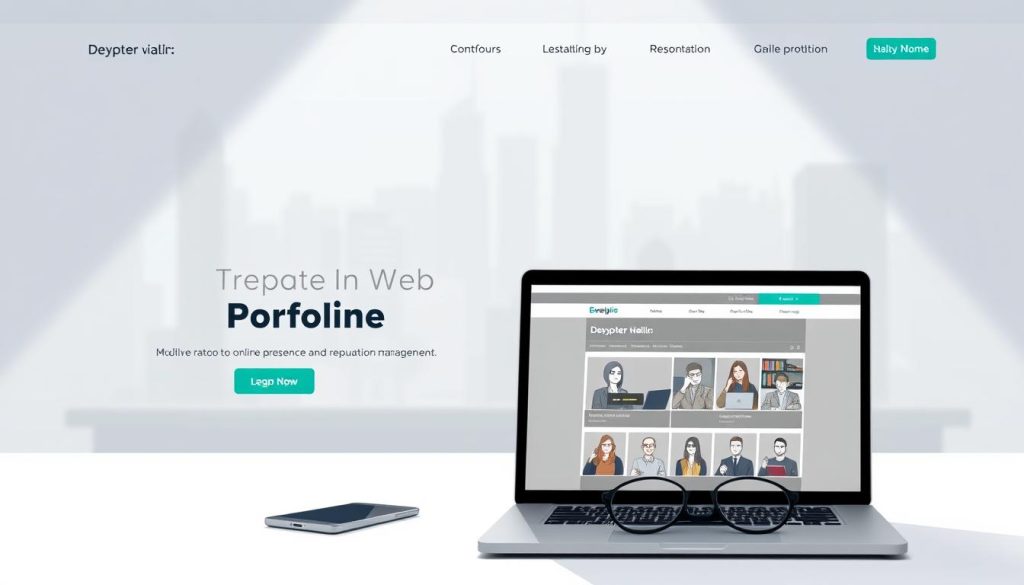What if a single online review or social media post could determine your next career opportunity? In today’s digital-first world, your expertise and value are judged long before you meet a client—often through curated content, client testimonials, and industry visibility. This reality makes managing your standing more critical than ever.
Studies show that businesses with strong reputations outperform competitors by up to 15% financially, and independents face similar stakes. Your digital footprint—every blog post, LinkedIn interaction, or client collaboration—shapes how others perceive your reliability and skills. Without the shield of a corporate brand, your personal branding strategy becomes your primary tool for securing trust and opportunities.
Consider this: 76% of clients choose service providers based on perceived credibility. For independents, consistent effort in showcasing your work and maintaining transparent communication isn’t optional—it’s how you survive in competitive markets. The challenge? Balancing authenticity with strategic visibility to attract high-quality projects without appearing overly self-promotional.
Table of Contents
Key Takeaways
- Your online presence directly impacts client trust and career growth
- Reputation management requires both digital savvy and interpersonal consistency
- Independents must work 3x harder to establish credibility than corporate professionals
- Strategic content creation can position you as an industry thought leader
- Client relationships now extend beyond transactions to public validation
Understanding the Importance of a Professional Reputation
Your digital interactions now shape career opportunities as much as face-to-face meetings. Every online comment, portfolio update, or client review builds a narrative about your capabilities. This digital-first reality means your standing evolves with each project and interaction.
What Does Reputation Mean in the Modern Digital Age?
Today’s perception of credibility blends traditional expertise with digital proof points. A 2023 LinkedIn study found 78% of hiring managers prioritize candidates with visible thought leadership. Your online presence acts as a 24/7 showcase of your skills and values.
Key elements shaping modern credibility include:
- Consistency between offline work quality and digital portrayals
- Search engine results showing client testimonials or published articles
- Social media engagement demonstrating industry knowledge
Impacts on Career and Business Growth
Strong credibility directly influences earning potential and project access. Freelancers with optimized profiles secure 34% more interview requests than peers with sparse digital footprints, according to Upwork data.
| Aspect | Traditional Reputation | Digital Reputation |
|---|---|---|
| Visibility | Local networks | Global reach |
| Validation | Word-of-mouth | Online reviews |
| Speed of Impact | Months/years | Hours/days |
The table above shows how digital channels accelerate both opportunities and risks. Early investments in building trust yield long-term benefits, with 65% of independents reporting repeat clients from strong online reputations.
Defining Your Unique Brand Identity

Your brand acts as your career fingerprint – the distinct combination of qualities that makes clients choose you over others. Start by asking: « What lasting impression do I want to leave in every interaction? » This clarity transforms scattered efforts into focused growth.
Clarifying Your Values and Expertise
Your core values shape decisions like a compass. A graphic designer might prioritize « visual storytelling that drives conversions, » while a consultant focuses on « ethical scaling strategies. » List 3 non-negotiable principles guiding your work.
Next, map your expertise against market needs. 58% of clients prefer specialists over generalists, according to 2023 freelance data. Narrow your focus to master specific skills others can’t easily replicate.
Identifying Your Unique Selling Proposition
Your USP answers: « Why should clients invest in me versus competitors? » Combine these elements:
- Technical abilities (certifications, tools mastered)
- Differentiated approach (your signature workflow)
- Personality traits (reliability, creative problem-solving)
For example:
« I help sustainable fashion brands increase sales by 40% through targeted Instagram marketing strategies that align with eco-values. »
This specificity becomes your marketing cornerstone. Update your USP quarterly as your skills evolve and industry trends shift.
Establishing an Effective Online Presence

Every click on your site is a potential client evaluating your competence. Unlike temporary social media posts, your website offers controlled storytelling where quality and clarity directly influence opportunities. 72% of French independents report losing projects due to poorly optimized sites, according to 2024 digital marketing data.
Building a Professional Website as Your Digital Storefront
Your site acts as a 24/7 portfolio and client conversion tool. Include case studies showing measurable results—like how you increased a client’s sales by 30% or streamlined operations. These concrete examples build trust faster than generic service lists.
Align visual elements with your brand voice through color schemes and imagery that reflect your work philosophy. A Paris-based UX designer might use minimalist layouts, while a Marseille marketing consultant could emphasize vibrant local culture.
Three essentials for impactful websites:
- SEO-optimized content using location-specific keywords (« freelance web designer Lyon »)
- Mobile-first design loading in under 2 seconds
- Clear call-to-actions guiding visitors to contact forms or project galleries
Regularly update your blog with industry insights—clients perceive active content creators as 45% more credible. Integrate client testimonials naturally into service pages rather than isolating them in a separate section.
For those needing design expertise, our website design guide details technical best practices. Remember: your site isn’t just about aesthetics—it’s a strategic marketing tool shaping perceptions before you ever meet clients.
Leveraging Content Creation to Demonstrate Expertise
Did you know 73% of clients review content before hiring independents? Your articles and videos act as silent salespeople, working around the clock to showcase your skills. Strategic content marketing builds authority faster than traditional networking, with LinkedIn data showing creators receive 3x more inbound project inquiries.
Blogging and Vlogging Strategies
Mix formats to engage different learning styles. While articles allow deep dives into industry trends, videos create personal connections through tone and visual examples. A balanced approach covers:
- Weekly 800-word posts analyzing emerging tools in your field
- Biweekly 5-minute tutorials demonstrating practical applications
- Monthly case studies showing measurable client results
This table shows how content types complement each other:
| Format | Best For | Client Impact |
|---|---|---|
| Articles | Detailed analysis | Establishes depth |
| Videos | Process demonstrations | Builds relatability |
| Case Studies | Proving outcomes | Enhances trust |
Focus on solving specific problems. For example: « How I reduced inventory costs by 22% using AI forecasting » immediately shows value. Update older posts with fresh data – 68% of clients check content dates when evaluating expertise.
Ways to Build Your Professional Reputation
78% of clients discover independents through social posts before initiating contact. Your digital interactions create opportunities – or barriers – depending on how strategically you present your skills. Small, consistent actions compound into lasting credibility that attracts premium projects.
Actionable Steps for Continuous Improvement
Start with weekly reputation audits. Track search results for your name, update portfolio samples, and request client feedback. This table shows effective methods:
| Method | Tools | Impact |
|---|---|---|
| Skill Demonstration | Case Studies | +40% Trust |
| Peer Engagement | LinkedIn Groups | +28% Visibility |
| Content Sharing | Industry Blogs | +35% Authority |
Focus on measurable growth. For example, aim to increase LinkedIn engagement by 15% monthly through targeted comments on industry trends.
Integrating Social Media Strategies
Platforms like LinkedIn and Twitter act as virtual networking events. Optimize profiles with:
- Keyword-rich headlines (e.g., « AI Marketing Strategist »)
- Project highlights showing client outcomes
- Authentic storytelling about work philosophy
Share bite-sized insights twice weekly. A 2024 study found independents posting industry analysis gain 3x more project inquiries than those sharing only promotional content. Balance expertise with approachability – clients want skilled collaborators, not impersonal brands.
Implementing Damage Control Techniques
Imagine a client publicly questions your work quality—how you respond defines future opportunities. Even minor missteps can escalate quickly in digital spaces, making strategic damage control essential for preserving trust. The right approach transforms crises into credibility-building moments.
Acknowledging and Learning from Mistakes
Address errors promptly and transparently. Research shows clients forgive 68% of mistakes when handled with sincerity versus 23% when ignored. Follow these steps:
- Respond within 24 hours to show accountability
- Apologize specifically (« I underestimated the timeline »)
- Outline corrective actions with deadlines
For example, a delayed project might require: « I’ll deliver Phase 1 by Friday and waive 15% fees for the inconvenience. » This demonstrates problem-solving, not excuses.
Effective Approaches to Manage Negative Feedback
Turn criticism into improvement opportunities. Use this framework:
| Situation | Reactive Approach | Proactive Solution |
|---|---|---|
| Negative Review | Defensive response | Public apology + private resolution |
| Missed Deadline | Blame external factors | Revised timeline + compensation |
Create a feedback loop by asking: « How can I improve this outcome? » Clients appreciate collaborative solutions—83% return after resolved issues according to 2024 CX data.
Rebuilding trust requires visible changes. Share updates like revised workflows or new quality checks. For deeper strategies, explore our guide to secure client relationships through transparent communication.
Utilizing Social Media for Reputation Management
Your social media presence isn’t just a digital handshake—it’s a dynamic tool shaping how clients and peers perceive your expertise. Strategic use of these platforms transforms casual interactions into career-building opportunities, especially when 70% of professionals credit networking for new projects.
Crafting Profiles That Command Attention
Start by polishing key platform profiles. LinkedIn data shows complete profiles receive 40% more connection requests. Highlight measurable achievements rather than generic job descriptions. For example: “Increased client retention by 25% through tailored marketing strategies” demonstrates clear value.
Engage daily with industry-specific content. Comment on trending topics using data-driven insights to showcase knowledge. A 2024 study found independents who share analysis gain 3x more project inquiries than those posting promotional content alone.
Join niche groups to connect with decision-makers. Platforms like Twitter Spaces or LinkedIn Groups let you discuss challenges colleagues face. This positions you as a collaborative problem-solver, not just a service provider.
Leverage reviews by encouraging satisfied clients to highlight specific strengths. One authentic testimonial can outweigh ten self-written claims. For deeper strategies, explore how strategic networking opens doors to unexpected collaborations.
Consistency matters—schedule 15 minutes daily to share insights or celebrate peers’ wins. This builds genuine relationships that amplify your visibility while reinforcing trust.
FAQ
Why does online presence matter for independent professionals?
A strong digital footprint acts as your 24/7 portfolio, showcasing skills to potential clients and collaborators. Platforms like LinkedIn or a personal website help establish credibility, making you discoverable in a competitive market.
How do I define my unique brand as an independent worker?
Start by identifying core strengths and values that set you apart. Combine this with specific industry insights you offer—like niche problem-solving techniques—to create a clear message that resonates with your target audience.
What elements are essential for a professional website?
Focus on clarity and purpose: include a portfolio of past projects, client testimonials, and a detailed services page. Ensure mobile optimization and integrate contact forms or scheduling tools to streamline client interactions.
Which types of content best demonstrate expertise?
Case studies showcasing real-world results, thought leadership articles on industry trends, and short video tutorials addressing common challenges are highly effective. Tailor formats to platforms where your audience engages most.
What daily habits strengthen my career credibility?
Consistently share insights on industry developments, engage authentically with peers online, and seek feedback after projects. Regular skill updates through certifications or workshops also reinforce your commitment to growth.
How should I handle negative feedback publicly?
Respond promptly and professionally, acknowledging concerns without defensiveness. Offer solutions privately when possible, and use criticism to improve processes. Transparency often turns challenges into trust-building opportunities.
Which social platforms are best for reputation building?
LinkedIn remains critical for B2B connections, while Instagram or YouTube work for visual industries. Niche forums like GitHub (for developers) or Behance (designers) also provide targeted visibility among peers and decision-makers.





